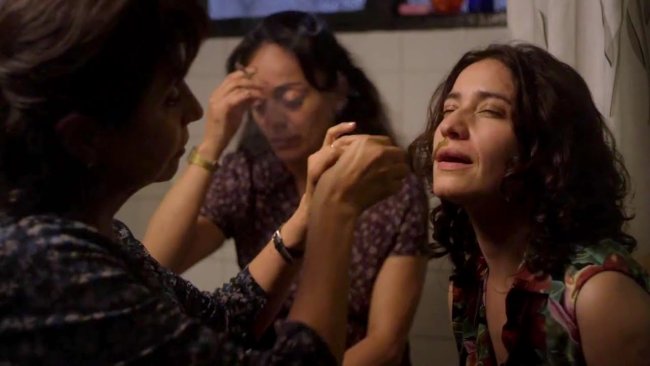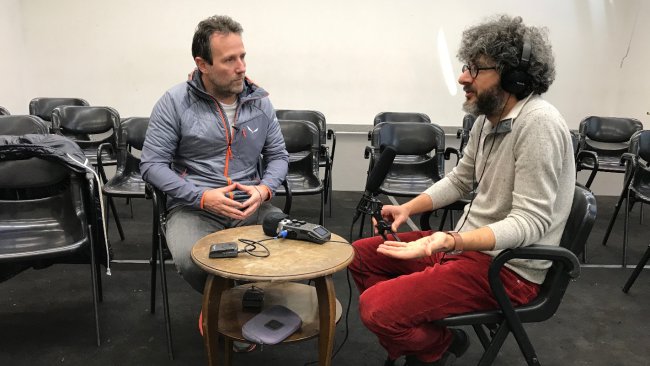O que arde
[…] The film is more than a fiction that uses the tools of documentary. Sometimes it portrays real life as science fiction.
[…] As in Andrei Tarkovsky’s and Apichatpong Weerasethakul’s works, «O que arde» let us feel the breath of those elemental «things that we never forget» («le cose che non passano mai» as Cesare Pavese wrote).
Text: Jorge Yglesias

Amador, a man released on parole after two years in jail for having started a huge fire in his hometown, his elderly mother (Benedicta), three cows, a dog and the Galician rural landscape are the main characters of Oliver Laxe´s O que arde, winner of the Jury Prize at Un Certain Regard section of the last Cannes Film Festival. This down-to-earth story of guilt and decline of a way of life achieves intensity and credibility through its amateur performers and the pristine innocence they emanate, their countenances showing the handwriting of life, something missing from professional thespians´ fifteen-seconds-faces.
Filmed in Laxe´s house, in the small nowadays abandoned town, where his mother was born, O que arde, described by Laxe as a “dry melodrama”, stresses the hic et nunc of a Spain stopped some centuries ago on the verge of being destroyed by a ruthless progress. « Are you hungry? », the first words Benedicta says when Amador comes to her after two years in prison, as if he were away for only some hours, are evidence of the timeless world they inhabit, but the film is more than a fiction that uses the tools of documentary. Sometimes it portrays real life as science fiction. In the opening, one of the more impressive in recent cinema, a mesmerizing trip through a night wood ends in an ordeal of blind devastation. A succession of shots (the effect before the cause) displays a dance of falling Eucalyptus trees that create an eerie ambiance that prevails even when we see the reason for the destruction: a squad of excavators that seem to move on their own, dehumanizing forces doing an inhuman work. These stunning images were created by Mauro Herce, one of the best contemporary Spanish cinematographers.
The film is ruled by a gaze full of pity. After the mysterious overture, a long take of trunks and arms of people whose faces we don´t see (an homage to Robert Bresson´s L´Argent), carrying a dossier of Amador and talking about his crime, precedes the first apparition of the pyromaniac, on his way home, while the voice of Andreas Scholl embroiders a section (Cum dederit) of Nisi Dominus, Antonio Vivaldi´s compassionate rendering of Psalm 127, in praise of those who build under the blessing of God and wait to sleep thanks to his love. Three times this musical theme is heard in the movie, embracing human beings and landscapes. This «lent greatness» (to quote the phrase of Woody Allen) in an auteur film can be problematic (as Johann Sebastian Bach in Andrei Tarkovsky) because it can lead to losing control of the work. David Machado, the sound designer of O que arde, manages to make of Cum dederit another character in the story. But he does not succeed when, with a fan devotion more appropriate to main stream cinema, introduces Leonard Cohen´s Suzanne (intriguingly adopted by Werner Herzog in Fata Morgana) in the ride in the veterinarian car. Even the sick cow is didactically manipulated to create a Mozartian state of communion.
O que arde reaches an emotive strength in its depiction of humble everyday life: Benedicta drying Amador’s socks of in the front part of the oven or protecting herself from the rain inside a cavity of the trunk of a huge tree, Amador toasting a slice of bread, or putting his shoes on, or caressing the dog, and mother, son, dog and three cows leaving home. This is also seen in those shots where the landscape seems to be absorbed by the fog or a vehicle seen in the distance runs through a bendy road. Those instants when meaning is reduced and compassion emerges contrast with those slanted composition of human figures crossing the slightly sloping field as if the film might find a balance (physical and spiritual) in this disparity.
As in Andrei Tarkovsky´s and Apichatpong Weerasethakul´s works, O que arde let us feel the breath of those elemental «things that we never forget» (le cose che non passano mai as Cesare Pavese wrote). Its director, a relevant member of the other side of Spanish cinema, has said art is an esoteric tool to explore the hidden, what is in shadows, and how light (“a veil” according to a Sufi mystic) doesn´t let us see. Through cinema, nature speaks to us and heals our sufferings. For him, a believer, the camera is a means to pray. Images and sounds transcend a modernity that can be a deadly fire (in a TV news a report about the replacement of an ancient bell for an imitation tells us that the new one is less deep and has no soul). If a film can be a prayer then O que arde is one made for those who dwell between a painful past and an empty future.
This article contains a third-party video. If you would like to watch the video, please adjust your settings.
Watch
Screenings in December 2021 at the Filmgilde Biel/Guilde biennoise du film
Info
O que arde | Film | Oliver Laxe | ES-FR-LUX 2019 | 85’
Prix du Jury Un Certain Regard at Festival de Cannes 2019
First published: November 27, 2019



